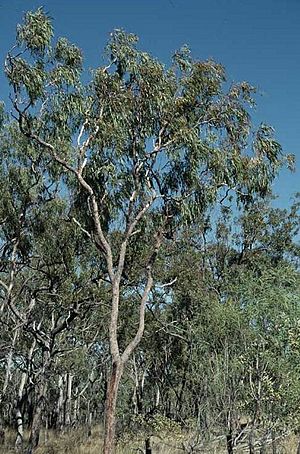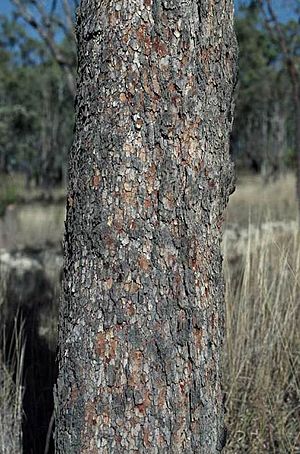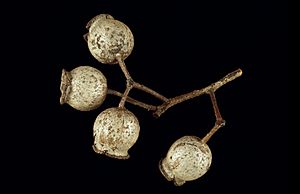Corymbia umbonata facts for kids
Quick facts for kids Rusty bloodwood |
|
|---|---|
 |
|
| Scientific classification | |
| Genus: |
Corymbia
|
| Species: |
umbonata
|
| Synonyms | |
|
|
The rusty bloodwood (scientific name: Corymbia umbonata) is a type of tree found only in the northern part of Australia, known as the Top End of the Northern Territory. It gets its common name from its bark, which can sometimes look rusty. This tree has rough bark on its trunk and branches, and its leaves are shaped like a spear. When it flowers, it produces creamy white blossoms, and its fruit looks like a small urn.
What the Rusty Bloodwood Looks Like
The rusty bloodwood tree usually grows up to about 17 meters (about 56 feet) tall. It has a special woody swelling at its base called a lignotuber. This helps the tree regrow if the top part is damaged, for example, by a bushfire.
The bark on the trunk and often on the branches is thin and rough. It has a pattern like a mosaic or small tiles, which is called "tessellated." Higher up, the bark is smooth and can be creamy pink or light grey.
Young plants and new shoots that grow after the tree has been cut back (called coppice regrowth) have leaves that are egg-shaped or oval. These leaves are about 5.5 to 15 centimeters (2.2 to 5.9 inches) long and 2.5 to 5.5 centimeters (1.0 to 2.2 inches) wide. They also have a stalk, which is called a petiole.
Adult leaves are shaped like a spear or are slightly curved. They are longer, about 9 to 23 centimeters (3.5 to 9.1 inches) long and 0.8 to 2 centimeters (0.3 to 0.8 inches) wide. These leaves also have a petiole, which is about 1.4 to 4 centimeters (0.6 to 1.6 inches) long.
The tree's flower buds grow in groups of seven at the ends of its small branches. Each group of buds is on a main stalk called a peduncle, which is about 2 to 11 millimeters (0.1 to 0.4 inches) long. Each individual bud has its own small stalk, called a pedicel, about 3 to 13 millimeters (0.1 to 0.5 inches) long.
When the buds are ready to open, they are oval or pear-shaped, about 6 to 8 millimeters (0.2 to 0.3 inches) long and 5 to 6 millimeters (0.2 inches) wide. They have a rounded cap on top, which is called an operculum. The rusty bloodwood has been seen flowering in March and April, and its flowers are creamy white.
After flowering, the tree produces fruit. The fruit is a hard, dry container called a capsule, shaped like an urn. It is about 12 to 19 millimeters (0.5 to 0.7 inches) long and 11 to 16 millimeters (0.4 to 0.6 inches) wide. The parts that open to release the seeds (called valves) are hidden inside the fruit.
How the Rusty Bloodwood Got Its Name
The rusty bloodwood was first officially described in 1985 by two botanists, Denis John Carr and Stella Grace Maisie Carr. They first named it Eucalyptus umbonata in their book about eucalyptus species.
Later, in 1995, two other botanists, Ken Hill and Lawrie Johnson, decided to change its name to Corymbia umbonata. They published this change in a science journal called Telopea.
Where the Rusty Bloodwood Lives
The rusty bloodwood tree grows in open forests and savannah woodlands. These are types of habitats with scattered trees and lots of grass. You can find it in the Top End of the Northern Territory in Australia. This includes areas within national parks like Judbarra / Gregory, Kakadu, and Nitmiluk National Park.



